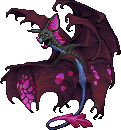Viewing 67vGY

Hardiness: 93
Appearance: 4
Emerged: 8:50 03.09.2024
Matured: 23:30 04.09.2024
Ombra Vespertos use their lower wings for active flight and their upper wings to glide as they sweep through the darkness of the caverns they call home. Colonies that dwell near water sources feed mainly on Senvida Nagantos, which they hunt by stalking the fish among the bioluminescent aquatic grass that grows within underground ponds and slow-moving streams. Those that roost in dryer environments eat Cielarka Cimos. Their guano encourages the growth of Kaverno Musko, a moss upon which Cielarka Cimos feed. Insect-feeding Ombra Vespertos tend to have brighter patterns, perhaps due to nutrients from their food source. Fast-breeding, with as many as three litters a year, Ombra Vespertos populations are kept in check by Monta Selos, their only natural predators. They rely on stealth and speed for evasion, as their claws, while strong enough to snatch a fish from the water or crush the hard shell of a Cielarka Cimo, are too weak to do more than scratch a Monta Selo’s tough hide. Communal by nature, Ombra Vespertos travel in groups, called flights, of at least three when hunting, and a roost may be home to as many as several hundred. It is not uncommon for a nursing female to adopt an orphaned pup and care for it as her own. Ombra Vespertos mate for life, and a widowed Ombra Vesperto rarely seeks out a new mate.
The creatures that dwell in this rather desolate world still display some diversity in appearance, eating habits, and social behavior. Whether they have fur or feathers, skin or scales, their unique genetic makeup allows for a variety of colors and markings within each species. Despite limitations in food sources, herbivores, omnivores, and carnivores are all present in the food chain, and each species requires specialized care within a laboratory. Although the artificial setting of housing units and breeding pods precludes most opportunities to study true interspecific behavior, the interactions within and between species has been studied extensively in the wilderness by scientists daring enough to venture beyond the outpost’s walls.
